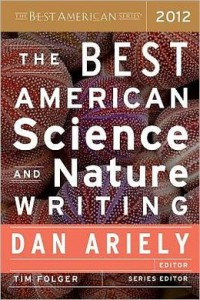Notes in the Margin: The Best American Science and Nature Writing
At the end of each year I look forward to the new annual collections of great writing known as the “Best American Series.” For people who don’t have enough time to indulge in a generous and interesting diversity of high quality literature during the year, choosing to read this series is a no-brainer.
There are many varieties of the “Best American” series – short stories, essays, sports, travel, etc.- but of course my favorite is “Best American Science and Nature Writing.” Each year the series editor collects a bunch of great articles, and invites a special guest editor select the top 20 articles.
This year Tim Folger, series editor and notable science writer himself, invited Dan Ariely, a behavioral psychologist at Duke, to do the honors. And he did something wonderful. This year’s volume includes a strong nod of appreciation to one of the great evolutionary biologists of the 20th century: Lynn Margulis. Her great contribution (and at the time great controversy) was the theory of endosymbiosis, or the idea that various cell organelles originated as separate organisms. She suggested that the cells in our bodies originated as collaborations of various free living microbial precursors, such as bacterial cells. These microbial precursors were absorbed by another cell, and a new type of cell emerged. For example, mitochondria developed from proteobacteria, and chloroplasts from cyanobacteria.
So if you aren’t familiar with the endosymbiotic theory, or you are simply thrilled every time you read about this great contribution to evolutionary theory, you will find this year’s volume of the “Best American Science and Nature Writing” a delight.

